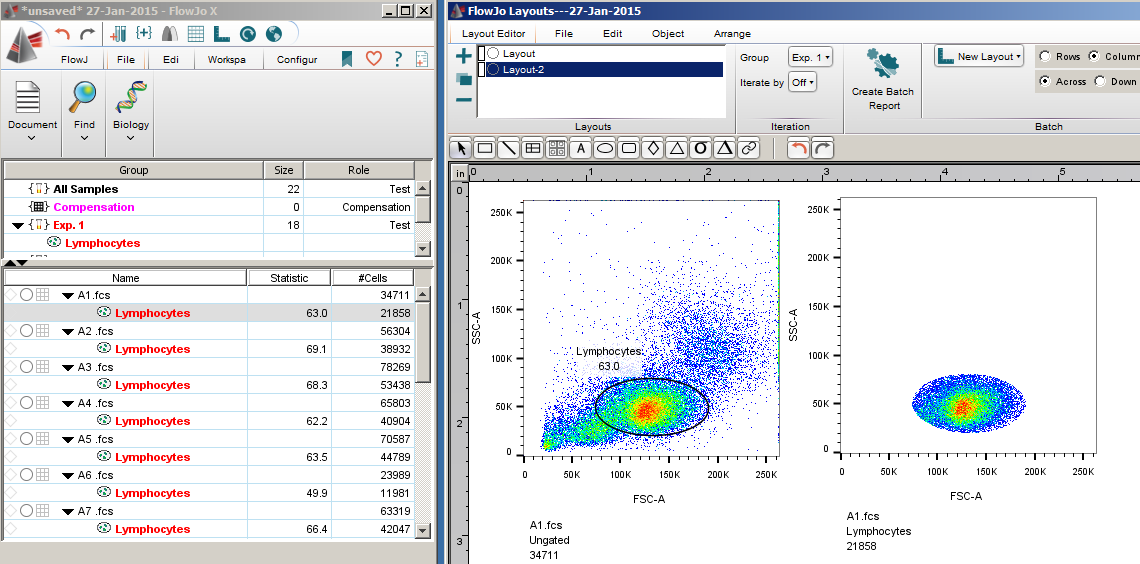
Examples of cytometers with syringes include the Attune, BD fortessa HTS, and Helios. In this case, you will find the data is interrupted at regular intervals as the syringe empties and refills. There is one situation where you will expect to find interruptions in the time parameter: data acquired by syringe injection. However if clogging is a recurring problem, you may consider filtering your samples prior to running them. If you are using FlowJo, you can use the export function to create new fcs files where all slashes are replaced with underscores. Please note: algorithms do not like slashes, so if any of the parameter names contain slashes, extra steps should be taken to remove them. Alternatively algorithms like FlowClean and FlowAI could also be used to clean the data. In some cases you can draw a gate manually – for example all of the data after 10 in the last panel below. It may be possible to salvage the data by gating on the portion of data where the signal was steady. The images below show problematic data – the gaps suggest there may have been clogs. If there were no issues with the fluidics, you should see an even signal for the duration of your sample. Using the backgating technique to first gate on SiglecF+ granulocytes and then look at the FSC and SSC, you can determine that these voltages for FSC and SSC are appropriate for this cell population.Ĭlogs and Other Issues with Cytometer Fluidicsīefore analyzing your data, it’s a good idea to look at the time parameter to examine the cytometer fluidics. The images below show a different experiment with different voltages using the same tissue. However, if the goal of the experiment is to look at granulocytes, the SSC should be decreased. In this scenario it is best to consider the goal of the experiment – if T cells or lymphocytes are the only cells of interest, these voltages work well. The second plots shows that my T cell population is in the middle of the FSC SSC plot, but the third plot shows that the granulocyte population is on the top axis. In this case, I gated on CD4+ T cells or F4/80+CD11b+ granulocytes and then examined the FSC and SSC of the gated cells. To determine if the settings are correct, you can use a technique called backgating. However, I’ve mentioned that it can be more challenging to set FSC and SSC for digested tissue. The first plot shows the FSC and SSC for ungated cells and at first glance, these FSC and SSC voltages look great.

The above images show data from a tissue digest.
FLOWJO 10 BACKGATING SOFTWARE
From this post, you should be able to identify if there are major issues with the instrument settings (which can only be fixed by re-recording the samples) or if the samples need to be cleaned up in analysis software with gates or a new compensation matrix. There are a lot of ways to get bad flow cytometry data – in this post I’ll focus on the reasons that I feel are the easiest to identify and fix. So in this post I’d like to go over some examples of bad data to assist novice flow cytometrists. It was just a skill that I eventually picked up. Looking back, I realized that no one really ever told me what bad data looks like. But for novice flow cytometrists this step of identifying problems can be very difficult. With baking this is easy for everyone, even a novice – you taste your food and immediately know it doesn’t taste good.
FLOWJO 10 BACKGATING HOW TO
The step that is often skipped is how to assess your results to identify problems. Flow cytometry training materials usually focus on the protocol of how to perform a flow cytometry experiment, but they don’t always cover how to troubleshoot.


As I created my flow cytometry training materials I realized that I didn’t cover all of these steps. It’s been a while since I learned flow cytometry, but baking bread reminded me of the process of learning a new skill: follow a protocol, assess the results and identify problems, determine how to fix the problems, and repeat the protocol with adjustments to address the problems.
FLOWJO 10 BACKGATING FREE
And while I learned to perfect my bread in my free time, I spent a lot of my working hours on training materials for new flow cytometrists – that’s when I started to realize some similarities between these two tasks. I decided to take on baking sourdough bread (like many other quarantined individuals). When the global pandemic hit and Chicago’s shelter in place orders prevented me from going into the lab, I started doing some experiments in my kitchen instead.


 0 kommentar(er)
0 kommentar(er)
